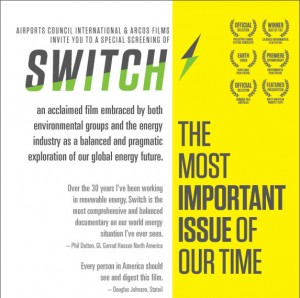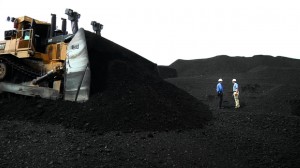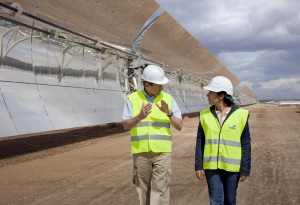 Geo-politics, defense, economics, domestic politics, environmentalism, job creation… these are just a few of the arenas through which the topic of the world’s energy sources and consumption weave, and every day the debates on the subject grow more heated and important. What is often lost in these conversations –which tend to toss around big statistics with little context– is any sort of public understanding of how energy infrastructures across the world work, how they’re changing, and the true scale that they operate on. Harry Lynch’s documentary Switch goes a long way to changing all of that, as it follows the travels of Dr. Scott Tinker across the globe as he investigates virtually every major technique by which energy is produced by man on this planet and seeks to answer the question of how we’ll be powering ourselves in 50 years. Fortunately, Lynch and Tinker have together created a spectacular documentary that is informative, objective, pragmatic, and –most happily– very very entertaining.
Geo-politics, defense, economics, domestic politics, environmentalism, job creation… these are just a few of the arenas through which the topic of the world’s energy sources and consumption weave, and every day the debates on the subject grow more heated and important. What is often lost in these conversations –which tend to toss around big statistics with little context– is any sort of public understanding of how energy infrastructures across the world work, how they’re changing, and the true scale that they operate on. Harry Lynch’s documentary Switch goes a long way to changing all of that, as it follows the travels of Dr. Scott Tinker across the globe as he investigates virtually every major technique by which energy is produced by man on this planet and seeks to answer the question of how we’ll be powering ourselves in 50 years. Fortunately, Lynch and Tinker have together created a spectacular documentary that is informative, objective, pragmatic, and –most happily– very very entertaining.
Dr. Scott Tinker –a professor at the University of Texas and a lecturer the world over on the topic of energy– acts as the narrator, guide, and interviewer of Switch, and it was a fine choice to put him front and center. The good doctor is a charismatic front-man who excels at extracting concise, informative answers out of interview subjects and doing so with a smile. It doesn’t hurt that he’s granted access to seemingly every concievable corner of the world’s energy infrastructure from the bowels of French nuclear facilities to the top of Norwegian windmills to a 200-mile-off-coast Shell Oil drilling station. You’ll see some of the biggest coal mines in the world, the most cutting-edge experimental bio fuel fields, one of only two massive solar towers that use hundreds of mirrors to bounce light into a giant solar panel, and even a nuclear waste recycling plant where they reclaim the +90% of the spent uranium rods that can be reused.
 All of these are contextualized in terms of the film’s own measurement system, which rates these facilities by the number of “people” they can power, based on an average voltage-draw per person per year (including devices, food transportation, car travel, house powering, etc. etc.). This gives you an idea why nuclear power and coal plants operate on a level that is so difficult to replicate with emerging technology.
All of these are contextualized in terms of the film’s own measurement system, which rates these facilities by the number of “people” they can power, based on an average voltage-draw per person per year (including devices, food transportation, car travel, house powering, etc. etc.). This gives you an idea why nuclear power and coal plants operate on a level that is so difficult to replicate with emerging technology.
It’s all about scale.
The film begins in the coal world, showing the inconceivably massive (and expensive) equipment that digs out the material, how it’s seperated, how it’s loaded onto trains, and how those trains splinter out across the country to create electricity. From there the film moves on to oil refining and between them demonstrates exactly what it is that we’re looking to replace here. It’s a pretty profound thing to witness even this fraction of what goes into our energy consumption in the world, and suddenly makes the case crystal clear why technologies that cost whole dollars simply can’t scale up to compete with technologies that costs hundredths of cents at this point. Furthermore, the film makes it clear that despite so much hand-wringing, there is undoubtedly more than enough coal and oil to get us through the next century, even if the oil will get more expensive.
It’s staggering to think back on all of the technologies the film covers, and how it interweaves many of them with case-studies on countries or cities that have exploited several of them in concert to great success. It presents plausible solutions for how intermittent generators like wind and solar can be supplemented by things like natural gas, or how regional solutions like hydro-electric can ultimately contribute to a more positive global picture.
 Through it all there is Dr. Tinker, charmingly and practically tying all of this together, while refusing to shy away from tossing out harder questions, like asking of an offshore drilling operate what’s being done to prevent another Deepwater Horizon incident (answer: Shell has never had a major incident in 6 decades, and the industry has now created an infrastructure of response teams, equipment and oversight). The film notes the controversies around fracking and alludes to Fukishima, but ultimately errs on the side of pragmatism (the world’s going to keep on turning, the oil burning) and makes it clear that natural gas and nuclear really are our best bets for kicking the petroleum habit.
Through it all there is Dr. Tinker, charmingly and practically tying all of this together, while refusing to shy away from tossing out harder questions, like asking of an offshore drilling operate what’s being done to prevent another Deepwater Horizon incident (answer: Shell has never had a major incident in 6 decades, and the industry has now created an infrastructure of response teams, equipment and oversight). The film notes the controversies around fracking and alludes to Fukishima, but ultimately errs on the side of pragmatism (the world’s going to keep on turning, the oil burning) and makes it clear that natural gas and nuclear really are our best bets for kicking the petroleum habit.
Many of the interviews in Switch come with some sobering facts, and with all of the information presented it’s hard to deny the obvious fact that China and India are going to be bringing upwards of a half a billion people into a new consumer class, and that there simply is no cheap-enough clean system available right now, as those infrastructures are being built. Ultimately the answer is that a conflagration of technologies will meet these needs, that some things are just going to get more expensive, and that climate change is something we’re just going to have to react to, as even if the entire US went zero-footprint, there are two America’s worth of people hungry to start consuming. It surely leaves you with some things to think about as you flick the lights on and kick your heater into high gear.
 As for the presentation of the film (beyond Tinker’s excellent hosting) it’s a slickly professional, often beautiful doc that is never quite as overly-polished as a Participant Media film like Food, Inc, but is sharply shot nonetheless. This is no television special- it features crisp interviews and a daring camera that gets into some very interesting places and captures some very impacting images. The soundtrack is lively and supportive without being overly manipulative (a common irritation with issue-related documentaries), and the sparse motion-graphics are well done.
As for the presentation of the film (beyond Tinker’s excellent hosting) it’s a slickly professional, often beautiful doc that is never quite as overly-polished as a Participant Media film like Food, Inc, but is sharply shot nonetheless. This is no television special- it features crisp interviews and a daring camera that gets into some very interesting places and captures some very impacting images. The soundtrack is lively and supportive without being overly manipulative (a common irritation with issue-related documentaries), and the sparse motion-graphics are well done.
It’s a rare thing that such an alarming documentary is also so hopeful, and that such a dense topic is covered so entertainingly. Switch is simultaneously the most important, informative, and captivating documentary of the year, focused on a topic of absolutely paramount consequence to every creature on this planet. You simply must see it, so it’s a good thing every minute of it is so fascinating.
Rating: 




Out of a Possible 5 Stars
Some cool facts about the doc (you can find a trailer and more info here):
- Filmed in 11 countries
- 27 world-leading energy sites for all energy types
- Includes 53 expert interviews
- 24 renewable energy specialists
- 19 fossil energy specialists
- 11 plant managers for all energy types
- 10 of the world’s leading energy experts in government and academia
- 9 CEOs of international energy companies, fossil and renewable
- Switch took 2 years to film using 2 primary and 8 additional cameramen
- More than 500 hours of footage shot
- Switch took over 1 year to edit (for the film and the web videos), using 2 primary and 7 additional editors
- Dr. Scott Tinker has given over 450 invited lectures on energy in the past 10 years
- Switch is director Harry Lynch’s 6th documentary in the past 16 years.